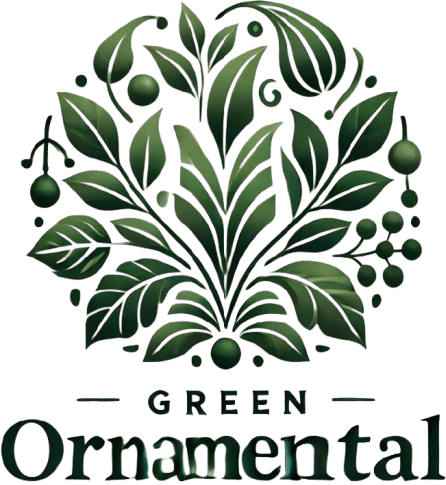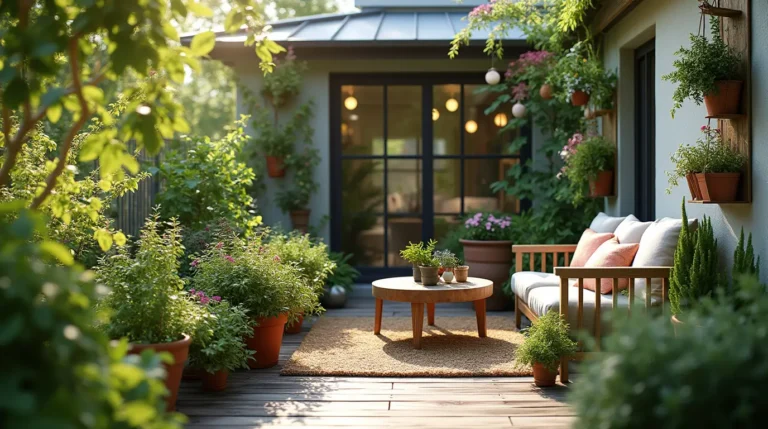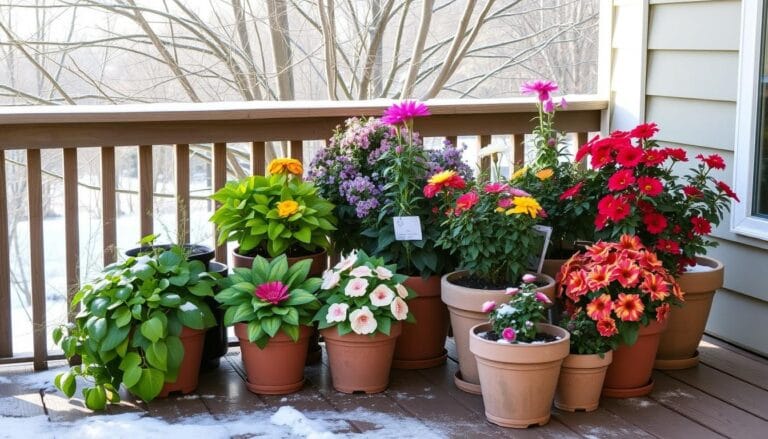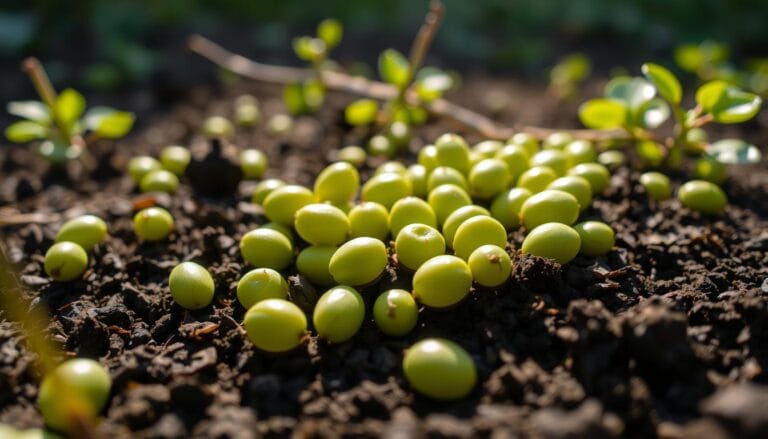Indoor Plant Tree Potting Guide:Maximize Growth and Beauty

As an indoor gardener, you know the importance of having the perfect environment for your plants to thrive. But often overlooked is a crucial element: the pot. For your indoor plant tree, choosing the right pot isn’t just about aesthetics, it significantly impacts its growth and health. The right pot will also contribute to the overall beauty of your home decor. Let’s dive into the details of selecting the perfect pot for your majestic indoor plant tree.
Whether you have a tall indoor tree or a green houseplant, the pot matters a lot. We’ll cover how to pick the right size and shape. This guide will help your indoor garden flourish for years to come.
Table of Contents
Understanding Plant Pot Sizing Basics
Caring for your indoor foliage plants, living greens, and indoor botanical wonders starts with the right pot size. The size of the pot matters for their health and growth. It’s about both the pot’s diameter and its volume.
What Plant Size Measurements Mean
Pot sizes are measured in inches, showing the container’s diameter. The volume is in gallons, showing how much the pot can hold. Knowing these helps pick the best home for your foliage plants, living greens, and indoor botanical friends.
Common Pot Size Standards
Pot sizes usually go up in 2-inch steps. A 10-inch pot is good for small fruits and herbs. A 14-inch pot fits leafy veggies. As plants grow, you might need bigger pots, like a 16-inch for small trees or an 18-inch for bigger veggies.
Volume and Capacity Guidelines
The pot’s volume, in gallons, is just as key as its diameter. A 4-inch pot holds 0.125 gallons, while a 30-inch pot can hold 30 gallons. Knowing these volumes helps give your foliage plants, living greens, and indoor botanical wonders the best growing space.
“The size of a plant pot relative to the plant’s size impacts soil moisture levels and growth.”
Why Proper Pot Size Matters for Plant Health
The size of the pot is key for healthy plants. The right pot size supports your botanical décor and green interior. It’s crucial for your plants to thrive.
Big pots can slow down soil drying and cause root rot. Small pots can lead to root-bound plants and slow growth. But, the right size pot can boost plant growth by up to 40%.
Understanding the “perched water table” is vital when picking a pot. It affects root health and water use. So, think about it when choosing a pot for your natural air purifiers.
- Extra Small pots (2 gallons/0.3 cubic feet) are good for plants like Arugula and Basil.
- Small pots (2-3 gallons/0.3-0.46 cubic feet) are best for herbs and leafy greens.
- Medium pots (5-7 gallons/0.69-0.92 cubic feet) suit larger plants like Lemon Grass.
- Large pots (10 gallons/1.5 cubic feet) are best for plants like Sweet Potatoes.
- Extra Large pots (20+ gallons/2.73+ cubic feet) are great for botanical décor like Fig Trees.
Choosing the right pot size is crucial for your green interiors. It helps your plants grow well and look good. This makes your space both functional and beautiful.
Essential Factors for Indoor Plant Tree Success
Understanding what your indoor plant tree needs is key to its health. This includes the root system, growth pattern, and space. Each factor is important for your houseplants or potted trees to do well indoors.
Root System Requirements
The size and shape of a plant’s roots affect the pot it needs. Succulents need shallow pots because of their small roots. Trees, on the other hand, require deeper pots for their large roots. Choosing the right pot size is crucial for your plant’s health.
Growth Pattern Considerations
Think about how your plant grows when picking a pot. Plants that spread out need wide, shallow pots. Upright plants do well in deeper pots, which help them grow tall.
Space and Stability Needs
The size your potted tree will grow to and its environment are also important. Make sure the pot is big enough for your plant to grow without getting too tight. Also, the pot should be stable to prevent your plant from falling over.
By considering these factors, you can pick the perfect pot for your indoor plant tree. This will help it thrive in your home or office for a long time.
Signs Your Plant Needs a Larger Pot
As your indoor plants grow, it’s key to watch their pot size needs. Not noticing when they need a bigger pot can harm their health. This can lead to stunted growth and root rot. By paying attention to the signs, your foliage plants and living greens will thrive in your indoor gardening space.
When roots start growing out of the pot’s drainage holes, it’s a clear sign. This means the plant has outgrown its home and needs more space. Also, if the soil dries out too fast, it’s a sign the plant is root-bound and needs a bigger pot.
If your plant looks top-heavy or is bulging over the pot’s sides, it needs a bigger home. A decrease in growth or flowering also means the plant needs more room.
- Roots growing out of drainage holes
- Soil drying out rapidly
- Plant looking top-heavy or bulging over pot sides
- Slowed growth or reduced flowering
For most indoor gardening fans, repotting plants every 1-2 years is a good rule. When it’s time to move them, pick a pot that’s 1-2 inches wider for small plants. For bigger plants, choose one that’s 2-4 inches wider. This helps the plant grow well without risking too much water.
“Paying attention to the signs that your plant needs a larger pot is crucial for its long-term health and vigor. With the right-sized container, your foliage plants and living greens will continue to flourish in your indoor gardening space.”
Different Pot Shapes and Their Impact
The shape of your plant pots can greatly affect your indoor space. From round to square, and tall to wide, each shape has its own benefits. These can improve the health and look of your indoor botanical friends.
Round vs. Square Containers
Round pots give a soft, natural feel to your green interiors. They’re great for small plants because they’re stable and less likely to tip. On the other hand, square pots have more room for plants and soil, which is good for bigger plants.
Tall vs. Wide Configurations
The height and width of your pots can affect your plants’ health. Taller pots help with air and water balance, which roots need. Wide pots, however, are better for plants with wide roots or that spread out a lot.
Aesthetic Considerations
The look of your plant pots also matters. Big pots can be focal points, while smaller ones can make a space look more unified. Think about how the shape, size, and material of your pots fit with your home’s style.
| Pot Shape | Benefits | Suitable Plants |
|---|---|---|
| Round | Stability, natural look | Smaller plants, herbs, succulents |
| Square | More surface area, increased volume | Larger plants, vegetables, trees |
| Tall | Better air-to-water ratio, oxygenation | Plants with deep root systems |
| Wide | Accommodates sprawling growth, varied watering | Plants with extensive root systems |
Knowing how different pot shapes affect your plants can help you choose better. This can make your botanical décor look better and keep your indoor botanical friends healthy.
Material Choices for Large Indoor Plants
Choosing the right pot for your indoor plant tree or natural air purifiers is key. The material can affect your houseplants‘ health and look. Options range from durable fiberglass to classic terracotta, each with its own benefits.
Fiberglass is a great pick for big indoor plants. It’s light but strong, perfect for growing roots. Plus, it lasts long and can move easily around your space.
Terracotta pots offer a natural vibe. They let plants breathe and drain well, keeping your indoor plant tree or houseplants healthy. They’re also cheap and can be reused, making them eco-friendly.
For a modern touch, glazed ceramic planters are a good choice. They come in many colors and finishes, fitting well with your home. These planters handle sunlight and cold, keeping your natural air purifiers in top shape.
“Fiberglass planters are preferred by almost all developers and landscapers for their durability, weather-resistance, and lightweight properties.”
Think about your plants’ needs and your home’s style when picking a pot. Consider drainage, weight, and how long it lasts. This way, you’ll create a beautiful and healthy indoor space.

Drainage and Water Management Solutions
Large indoor plants like potted trees and foliage plants need good drainage and water management. Knowing about the “perched water table” and setting up the right drainage can greatly help your indoor garden.
Understanding the Perched Water Table
The perched water table is a layer of wet soil at the bottom of a plant’s pot. It can cause waterlogging, harming the roots and leading to root rot. Good drainage is essential to avoid this and keep the soil’s air-to-water balance right.
Optimal Drainage Setup
Use taller pots for your indoor plants for better drainage. Taller pots help the soil dry out faster between waterings. Also, make sure your pots have enough holes at the bottom for water to drain out.
Think about your plants’ water needs when picking them. Tall, narrow pots dry out quicker than wide, shallow ones. Choose plants that do well in your preferred pot size and shape. This way, you can create a healthy space for your indoor plants.
| Plant Type | Water Needs | Pot Shape Preference |
|---|---|---|
| Philodendrons | High | Tall, narrow |
| Cacti and Succulents | Low | Wide, shallow |
| Boston Ferns | High | Tall, narrow |
| Elephant Ears | High | Wide, shallow |
By knowing your plants’ drainage and water needs, you can make a great indoor garden. It will be full of beautiful potted trees, foliage plants, and other greenery.
Matching Pot Style with Home Décor
Choosing the right pot for your living greens is key to a beautiful botanical décor. The pot should match your plant’s needs and your home’s style. This creates a cohesive look.
Think about your home’s color scheme and style. Pots in white, gray, or beige can look modern. On the other hand, colors like blue, green, or earth tones can add a boho-chic vibe. Textured or patterned pots can also add interest to your botanical décor.
Hanging planters are great for small spaces. They let you add greenery without using up floor space. They’re perfect for kitchens and bedrooms, making your space look better and easier to care for.
| Pot Style | Décor Style | Example |
|---|---|---|
| Minimalist, Neutral Tones | Modern, Sleek | Self-Watering Planter |
| Vibrant Colors, Patterns | Boho, Eclectic | Handcrafted Terracotta Pot |
| Hanging or Wall-Mounted | Space-Saving, Functional | Hanging Planter |
| Unique, Artistic Designs | Contemporary, Unique | Illuminated Planter |
By picking pots that match your home’s style, you can make a beautiful botanical décor. This will highlight your living greens and show off your taste.

“Incorporating the right pot can transform a plant from a simple accessory to a true centerpiece of your indoor botanical design.”
Conclusion
Choosing the right pot for your large indoor plant is key for its health and long life. Knowing about plant pot sizing, root needs, and growth patterns helps. It also means picking the right material and drainage solutions.
This way, you can make stunning green interiors that clean the air in your home. The right pot balances your indoor plant tree‘s needs with your home’s look. With the right pot, your plants can reach their full potential and bring many benefits.
If you love plants or are new to green interiors, this guide helps you choose the best pot. It focuses on keeping your plants healthy and making your home better. You can turn your space into a lively, oxygen-filled area that boosts your health and happiness.
Bring nature indoors and let your indoor plant tree grow well in a good pot. The right pot can make your home better, clean the air, and add many benefits. It’s all about enjoying the beauty and energy of plants in your home.
FAQ
What plant size measurements refer to when choosing a pot?
What are the common pot size guidelines for different plants?
Why is proper pot size important for plant health and growth?
What factors should be considered when selecting a pot for an indoor plant tree?
What are the signs that indicate a plant needs a larger pot?
How do different pot shapes affect plant arrangement and care?
What are the benefits of different pot materials for large indoor plants?
How can proper drainage prevent issues like waterlogging and root rot?
How can you harmonize pot style with home décor for a cohesive look?
Source Links
- Finding the Right Size Pot For Your Plant | Simply Good Pots – https://simplygoodpots.com.au/finding-the-right-size-pot-for-your-plant/?srsltid=AfmBOori3u3NS6MmNYsb1gI7e9p5OK9qh9CeiXrryIIR6sNho0xdEXUQ
- How to choose the right pot for your plants – https://www.fargrohomeandgarden.co.uk/advice-and-inspiration/how-to-choose-the-right-pot-for-your-plants
- Plant Container Size Chart | PlanterCraft Blog – https://www.plantercraft.com/blogs/plant-container-size-chart/?srsltid=AfmBOopMpFn7fa5uT9lLANfR_t5QUA_zvDgeV_NdU0fvPnnlAS5aqxom
- What Pots To Use For Indoor Plants: Types, Size & Drainage – Homeowner.com – https://www.homeowner.com/smart-garden/what-pots-to-use-for-indoor-plants
- Step By Step Guide To Potting Your Houseplant – https://be.green/en/blog/step-by-step-guide-to-potting-your-houseplant?srsltid=AfmBOoowjpfuJP9sn8ttpoIS_Lte1JMGQEdt5zFMn48gp1OR6UvEDOb7
- Plant Container Size Chart | PlanterCraft Blog – https://www.plantercraft.com/blogs/plant-container-size-chart/?srsltid=AfmBOooi_Am7AQBEB8OeE8dWv8eoRz-Lkxw3Yiwcugqnt8kw9bOgxAlV
- Finding the Right Size Pot For Your Plant | Simply Good Pots – https://simplygoodpots.com.au/finding-the-right-size-pot-for-your-plant/?srsltid=AfmBOoq0IyJAg4Sl2DDGqFtA03sShc3s0dNn-fFeliaJvM-nuQz_7CVa
- Plant Pot Size Guide | Find the Best Shape and Size for Your Plants Jay Scotts Collection – https://jayscotts.com/blog/pot-shapes-for-plants/
- 10 Tips to Ensure Happy, Healthy Houseplants – https://www.bhg.com/gardening/houseplants/care/houseplant-care-guide/
- Environmental factors affecting plant growth – https://extension.oregonstate.edu/gardening/techniques/environmental-factors-affecting-plant-growth
- Plan for Tree Planting Success, Part 1: Site Selection | Fulton From the Ground Up – https://site.extension.uga.edu/fultonag/2024/01/plan-for-tree-planting-success-part-1-site-selection/
- 6 Common Signs Your Plant Has Outgrown Its Pot—Plus How to Fix It – https://www.thespruce.com/when-to-repot-plants-8550470
- Fall Repotting Guide – How to Repot Your Houseplants for Healthier Growth – https://mahoneysgarden.com/fall-repotting-houseplants-guide/
- How to Repot Indoor Plants – Dennis’ 7 Dees | Landscaping Services & Garden Centers – https://dennis7dees.com/repotting-indoor-plants/
- 12 Potted Trees You Can Grow Indoors to Enhance Your Space – https://www.realsimple.com/best-indoor-trees-7963336
- 29 Best Indoor Container Gardening Ideas – https://www.southernliving.com/garden/indoor-container-gardening?srsltid=AfmBOorVBJn-v8zBk0_1bEHVYYViHGTZsT65RI9YsFPZ1ZC0kDileh43
- Best Potting Soil for Indoor Plants – https://www.homedepot.com/c/ai/best-potting-soil-for-indoor-plants/9ba683603be9fa5395fab9017fc6e16e
- 7 BEST Material for Plant Pots | Industrial Expert Guide Jay Scotts Collection – https://jayscotts.com/blog/planter-materials/
- How to Water Indoor Plants the Right Way – https://www.bhg.com/gardening/houseplants/care/watering-houseplants/
- Top Plants That Absorb Water – https://stroberttree.com/blog/plants-that-absorb-water
- 10 Creative Ways to Use Pots and Planters – https://rootandvessel.com/blog/10-creative-ways-to-use-pots-and-planters
- 13 Cute Yet Useful Indoor Plant Pots Hand-Picked By Our Stylist – https://www.tasteofhome.com/collection/indoor-plant-pots/?srsltid=AfmBOoqOlOV8rQoZoSO8_ydB9jUCYPMqevqvpFVSrsaLSL8MW9xrXnrH
- Get inspired with decorating ideas using the Ficus robusta to bring your home to life – https://be.green/en/blog/get-inspired-with-decorating-ideas-using-the-ficus-robusta-bring-your?srsltid=AfmBOoqnM9Mv4l0i7DySsBKRr81VWIaOeV2RUfTcXRtLBc6IT1TEJcIE
- The Top 7 Health Benefits Of Houseplants — Seattle’s Favorite Garden Store Since 1924 – Swansons Nursery – https://www.swansonsnursery.com/blog/health-benefits-of-houseplants
- Houseplant – https://en.wikipedia.org/wiki/Houseplant
There are no reviews yet. Be the first one to write one.






